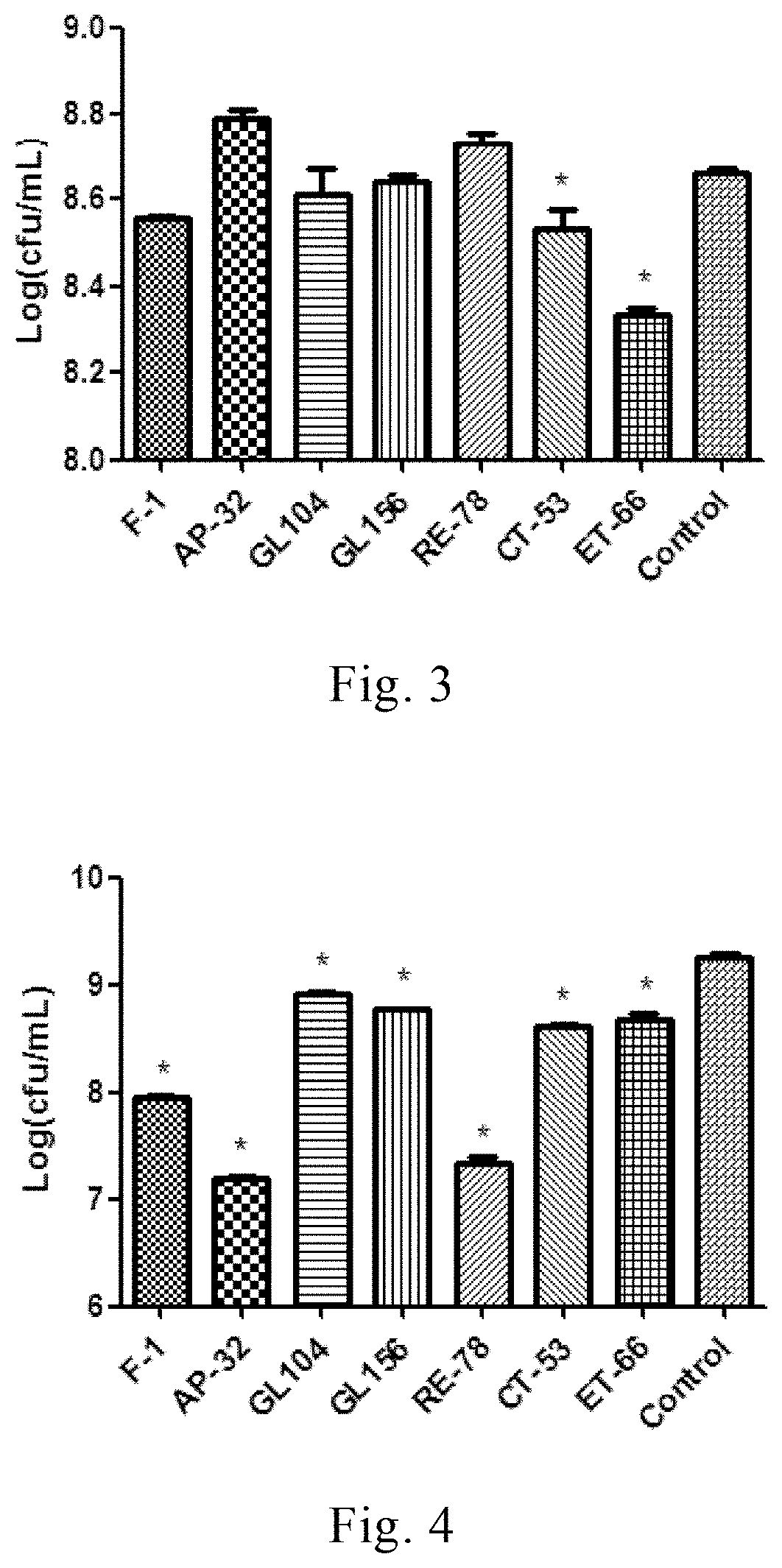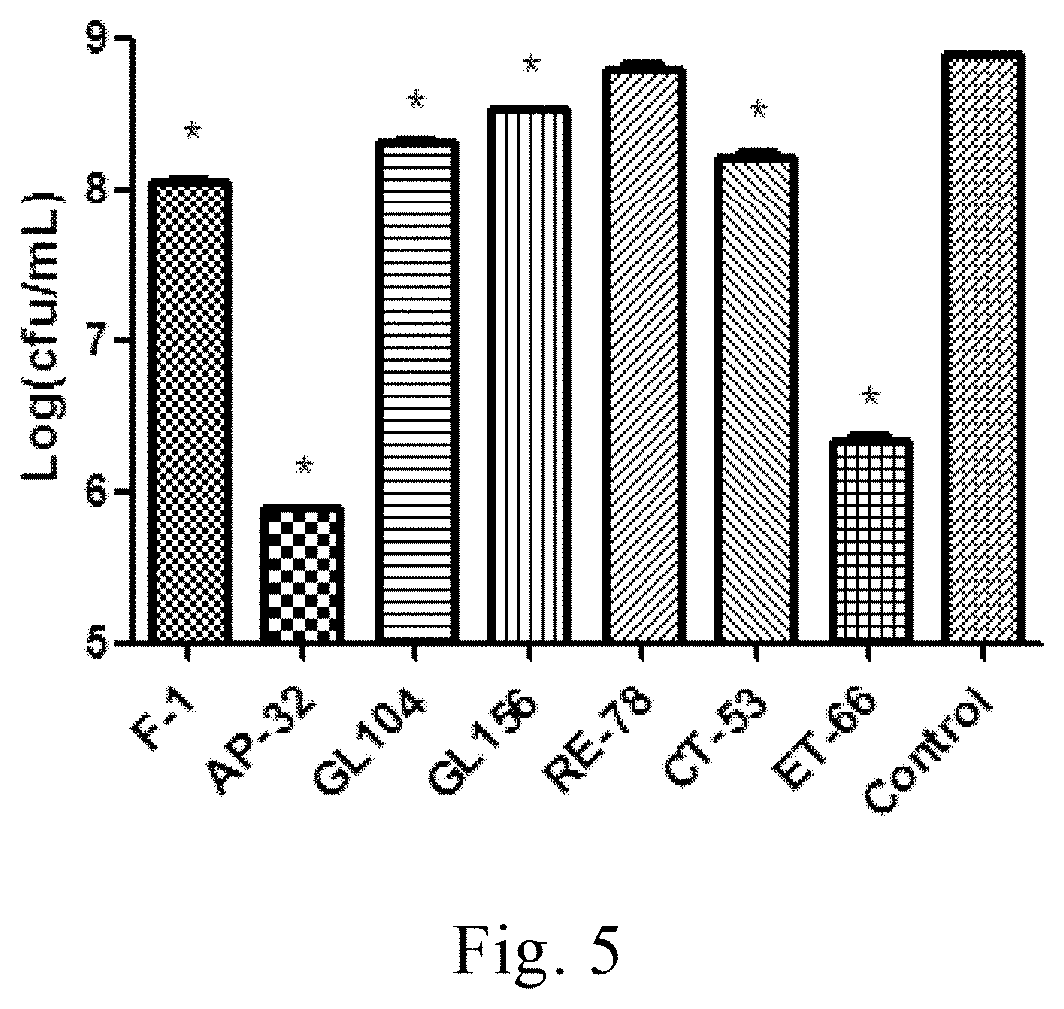Method of inhibiting oral pathogens
a technology of oral pathogens and inhibitors, which is applied in the direction of lactobacillus, unknown materials, drug compositions, etc., can solve the problems of tooth decay, space loss, and dental caries, and achieve the effect of maintaining the health of oral cavities and inhibiting the growth of oral pathogens
- Summary
- Abstract
- Description
- Claims
- Application Information
AI Technical Summary
Benefits of technology
Problems solved by technology
Method used
Image
Examples
embodiment i
Morphology and General Properties of the Lactobacilli Able to Maintain Oral Health
[0032]Use 16S rDNA sequence analysis and API bacteria identification system to identify the characteristics of the strains in taxonomy. The morphological characteristics and general properties of the abovementioned strains are listed in Table.2:
TABLE 2morphological characteristics and general properties oflactobacillus strainsStrainMorphological characteristicsLactobacillus1.While cultured in the MRS medium, the bodyacidophilus F-1thereof has a short or longer rod-like shape, and twoends of the body are rectangular-shaped. Theyoften appear in single bodies, pairs, or short chains.2.They are gram-positive bacilli, unlikely to generatespores, free of catalase, oxidase and motility, ableto grow in aerobic and anaerobic environments,most suitable to grow at a temperature of 37 ± 1° C.They belong to a facultative heterofermentativestrains and do not generate gas in glucosemetabolism.Lactobacillus1.While cul...
embodiment ii
Analyzing the Ability of Generating Hydrogen Peroxide to Verify the Teeth-whitening Function
[0033]Detect the hydrogen peroxide-generating ability of Lactobacillus acidophilus F-1 strain, Lactobacillus salivarius subsp. salicinius AP-32 strain, Lactobacillus reuteri GL-104 strain, Lactobacillus paracasei GL-156 strain, Lactobacillus helveticus RE-78 strain, Lactobacillus rhamnosus CT-53 strain and Lactobacillus paracasei ET-66 strain to verify the performance of teeth whitening of the lactobacillus strains of the present invention. The steps of experiments are as follows:[0034]1. prepare a plate for screening the probiotics generating hydrogen peroxide;[0035]2. add 0.25 mg / ml trimethyl borane (TMB) and 0.01 mg / ml horseradish peroxidase (HRP) to the plate;[0036]3. divide the plate into four areas for cultivating strains;[0037]4. after two-day cultivation, blue color appears in the perimeters of the colonies where the lactobacillus strains generating hydrogen peroxide grow;[0038]5. use...
embodiment iii
Oral Pathogen-inhibiting Ability of Lactobacilli Able to Maintain Oral Health
[0045]Whether lactobacilli can protect oral health is dependent on whether their ability to resist oral pathogens is strong sufficiently. Oral pathogens not only include well-known Streptococcus mutans but also include Fusobacterium nucleatum subsp. polymorphum, Aggregatibacter actinomycetemcomitans, and Porphyromonas gingivalis. Streptococcus mutans causes caries; Fusobacterium nucleatum subsp. polymorphum causes periodontitis, oral odor, colon cancer, etc.; Aggregatibacter actinomycetemcomitans is the main bacterium causing periodontitis, stomatitis, and pneumonia; Porphyromonas gingivalis is the main factor causing adult periodontitis and oral odor. Besides, Fusobacterium nucleatum subsp. polymorphum, Aggregatibacter actinomycetemcomitans, and Porphyromonas gingivalis all generate sulfides. Therefore, Fusobacterium nucleatum subsp. Polymorphum and Aggregatibacter actinomycetemcomitans are also the specie...
PUM
 Login to View More
Login to View More Abstract
Description
Claims
Application Information
 Login to View More
Login to View More - R&D
- Intellectual Property
- Life Sciences
- Materials
- Tech Scout
- Unparalleled Data Quality
- Higher Quality Content
- 60% Fewer Hallucinations
Browse by: Latest US Patents, China's latest patents, Technical Efficacy Thesaurus, Application Domain, Technology Topic, Popular Technical Reports.
© 2025 PatSnap. All rights reserved.Legal|Privacy policy|Modern Slavery Act Transparency Statement|Sitemap|About US| Contact US: help@patsnap.com



